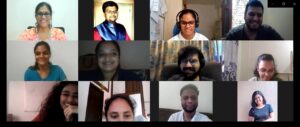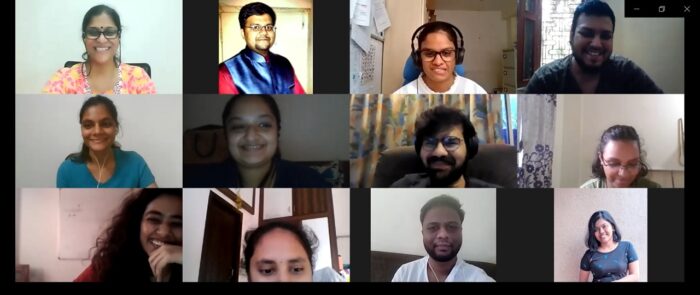Breaking down communication barriers as a teacher with Cerebral Palsy

This blog is dedicated to the wonderful Masters of Urban Infrastructure students and the lecturers at the Center for Water and Sanitation at CEPT University, for giving me such an incredible experience and setting the ‘gold standard’ for Zoom classes, and for giving me the inspiration to take my online teaching journey further.
This is the third and final blog in a series of blogs reflecting on my lecture on the use of PhotoVoice in the WASH sector I recently gave at the Center for Water and Sanitation (C-WAS) at CEPT University in Ahmedabad, India. I wrap up this series on a slightly more personal note, as I reflect on my individual experiences of teaching this class as a teacher with Cerebral Palsy.
On the day of the lecture, my colleague at C-WAS, Dr. Mona Iyer began the session once the students and other lecturers had logged into Zoom, and introduced me. As she gave an overview of the session and told the class about me, it suddenly hit me: I had become a university lecturer. I had done the very thing I have dreamed of doing for a long time. Those couple of minutes when Mona was talking about me as a teacher about to give a class was the realisation that I was about to do something on the one hand unexpected but on the other hand very, very exciting for me. Why? Well, I am simply not your conventional teacher! I have Cerebral Palsy, which affects my mobility, my hand co-ordination and most notably in a teaching perspective, my speech. When you first meet me, it may be slightly more challenging to understand me as my speech is not as clear as your average person. But after a lifetime of experience, I can assure you that almost all of the people I have met throughout my life have managed to ‘tune in’ to my voice as we talk within a couple of minutes. It was knowing this that gave me the confidence to say yes to Mona and her colleagues’ invitation to have the honour of teaching their class, thinking back to the various presentations I have given in person around the world in San Francisco, Ghana, Kenya and Vietnam. So, how do you make things accessible in an online class as a teacher with Cerebral Palsy?
Lesson 1: Talk slowly, engage fast!
It is interesting as I write this blog that I find myself talking about the tips my PhD supervisor had given me a few days before I taught this class. It is important to remember that the class may not have been taught by someone with speech impairments before, but this is not a reason not to teach at all. Speaking slowly, clearly and taking my time provides a chance for the class to get used to and ‘tune in’ to my voice, as due to my disability it may not be immediately clear what I am trying to tell you. I opened my lecture immediately with a question to the class about the different ways of seeing the ∑ sign, as discussed in my earlier blog. For me, this was a way of not just engaging the students with the topic of the lecture, but engaging in conversation and establishing early on that the students understand me, giving me the confidence to continue to teach for the next two hours. Reflecting back, I think this is an important way of encouraging the class not to be discouraged by my voice, and this was definitely the case as the students continued to engage and discuss various topics with me throughout the session. I was very open about the fact that if it was difficult to understand me at any point, students and lecturers were welcome to tell me, and I would repeat as needed, and that there was nothing to fear about this.
Lesson 2: Use slides effectively
I am a firm believer that in spite of anyone’s difficulties with speech, the focus of any class or conference audience when there are ‘lecturing’ parts should be on the teacher/speaker, rather than the slides. As I teach, I tend to put enough text on the slide to get a broad understanding of the key points that I am trying to make, without providing a script. It may be slightly more text than the average speaker, but it should not be overwhelming, because slides are there to support the teacher, but the teacher, whether they do or do not have a disability, is there to teach! Not having too much text also facilitates dialogue between the teacher with a disability and students, and provides greater scope for interaction and discussion. The golden rules of teaching and presenting for student interaction still apply!
Lesson 3: Other ‘voices’ can support you
One of the tricks I have used over the last six years to make teaching and presentations more accessible and exciting is to digitally bring in other speakers into my slides. I can, quite literally, make my presentations talk for me, like magic! In the last blog, I talked about how I brought in my colleagues, Brian Reed and Zara Ansari, into the lecture by integrating videos of them speaking into my presentation. Over the years, I have also used audio recordings from interviews and played them through my presentation. This not only makes the lecture more exciting because the students do not have to listen to my voice for two hours, but significantly aids and supports me as a teacher with a disability, because I can subtly plan in very short breaks for myself at different points by playing clips without impeding the flow of the lecture.
Lesson 4: Co-teach with others!
Before the lecture, I met with my colleague Siddh Doshi at C-WAS, and was very open with him about the fact that staff may need to step in here and there to facilitate discussions in the class, for the simple reason that I need to conserve energy for the parts where I was lecturing. As a teacher with a disability, if there are other staff members there to support you, you do not have to do it all! It was actually very enjoyable to share the floor and co-teach! My colleagues Dr. Mona Iyer and Siddh were pivotal as my co-teachers. Together they stepped in as and when needed to facilitate discussions with the class. Mona and Siddh were absolutely key to making the session as accessible for me as possible as a teacher, and were vital players in meeting my main aim which is to ensure my students had the most effective method of learning as possible.
Final thoughts and my next adventures in teaching
This lecture at C-WAS was one that I will remember well, and with great fondness for years to come. A few weeks after I gave this lecture, I look back on it with a really big smile, because on a personal level and as a woman with Cerebral Palsy, I feel that this was the day, this was the moment, that I realised that dream of lecturing to students fully. I can safely say that I got the seal of approval from my class and colleagues at C-WAS when at the end of the lecture, my Zoom screen was filled with everyone sending me claps and love hearts! An incredibly heart-warming moment! I felt I had hit the ‘gold standard’ of Zoom teaching (which for the record for my future students, C-WAS have now set the bar very high with this reaction with a flurry of emojis splattering my screen!) As a consultant, I am currently preparing to teach very soon again at another institution, this time on my work on the WASH needs of perimenopausal women. This experience with C-WAS could not have come at a better moment, and I go into my next online teaching adventures, together with the challenges my disability brings, with a great sense of confidence. People with different abilities can teach, we just need to make the space to let them try.
Acknowledgements
Thank you to Dr. Mona Iyer, Prof. Meera Mehta, Prof. Dinesh Mehta and Siddh Doshi for inviting me to give this lecture at C-WAS, CEPT University in Ahmedabad, and special thanks to the students on the Masters programme at C-WAS for giving me so much confidence from this experience. Thank you to Prof. Barbara Evans for making the introductions to make this lecture possible. Thanks go to the Sanitation Learning Hub at the Institute of Development Studies for commissioning and making this research possible, and to all of the researchers and their participants who provided the material for this lecture, and a special thanks to Brian Reed and Zara Ansari for their valuable video contributions for the session.
